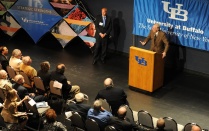UB launches center to find treatments for FOXG1 syndrome
Biologists Soo-Kyung and Jae Lee, whose daughter has FOXG1 syndrome, will lead the University at Buffalo's new FOXG1 Research Center. Photo: Douglas Levere/University at Buffalo
Research will be led by biologists Soo-Kyung and Jae Lee, whose daughter has the rare neurological disorder
Release Date: January 17, 2024
BUFFALO, N.Y. — University at Buffalo biologists Soo-Kyung and Jae Lee were already studying genetics and brain development when their daughter, Yuna, was born with a rare neurological disorder caused by a mutation of the FOXG1 gene.
So the Lees are well positioned — and motivated — to lead a research center dedicated to FOXG1.
UB’s new FOXG1 Research Center (FRC), set to launch in the coming months, aims to translate new discoveries from the lab to clinical trials and, ultimately, develop a cure for FOXG1 syndrome, as well as related autism spectrum disorder.
The FRC will be supported by the FOXG1 Research Foundation (FRF), as well as UB's College of Arts and Sciences and Office of the Vice President for Research and Economic Development.
“This center will make UB the home of the world’s premier research center devoted to the studies of FOXG1 syndrome, as well as provide our campus with a new neurodevelopmental biology training program and numerous research funding opportunities,” says Soo-Kyung Lee, PhD, Empire Innovation Professor and Om P. Bahl Endowed Professor in the UB Department of Biological Sciences, who is currently FRF’s chief scientific officer and will serve as the FRC’s inaugural director. “The FRC will harness the expertise of our faculty to unravel the remaining mysteries of FOXG1 syndrome and, hopefully, help Yuna and the other children impacted by this disorder.”
The FOXG1 gene is one of the most important genes for early brain development. A master regulator gene, FOXG1 carries the instructions for making a protein called forkhead box G1 that regulates the activity of other genes, many of which are crucial for cellular connectivity and communication. Impairment of FOXG1 causes cognitive and physical disabilities as well as life-threatening seizures.
There are only about 1,000 known patients diagnosed with FOXG1 syndrome worldwide, according to the FOXG1 Research Foundation. However, the FOXG1 gene has been linked to autism, Alzheimer’s disease and schizophrenia, suggesting that therapy development may be transferable to more common disorders.
There has also been a national push to better study and raise awareness for rare diseases, like FOXG1 syndrome. Last year, the Biden administration established the Advanced Research Projects Agency for Health (ARPA-H) within the National Institutes of Health, whose mission includes treating rare disorders.
The Lees, who joined UB in 2019, have established themselves as leading experts on FOXG1 syndrome since Yuna, now 14, was diagnosed with the disease at the age of 2. Their research has found that the FOXG1 gene and protein remain active in mice after birth, providing hope that some symptoms can be alleviated.
“Although we cannot go back and undo the damage to people who have FOXG1 syndrome, we may be able to modify the effects of the disease and increase their quality of life,” says Jae Lee, PhD, professor of biological sciences.
They’ve recently had success in this area. Mice who began receiving the Lees’ viral gene therapy a day after their birth saw some functions restored. Soo-Kyung Lee received a $1.5 million grant from the Simons Foundation Autism Research Initiative earlier this year to continue the research.
Planned research topics for the FRC include drug discovery, sensory issues like sleep disturbance and mood changes, and the role of mitochondria in neurodevelopmental disorders.
Joining the Lees at the FRC will be an interdisciplinary team of UB faculty, including expected new hires. Collaborators already in place include:
- Denise Ferkey, PhD, associate professor and associate chair of the Department of Biological Sciences;
- Michael Yu, PhD, associate professor of biological sciences;
- Wei Sun, PhD, associate professor and director of undergraduate studies of the Department of Communicative Disorders and Sciences;
- Priya Banerjee, PhD, associate professor of physics;
- Yungki Park, PhD, associate professor of biochemistry;
- Edward Kwon, DDS and PhD, assistant professor of oral biology.
Graduate students are also expected to conduct research in FRC labs.
Media Contact Information
Tom Dinki
News Content Manager
Physical sciences, economic development
Tel: 716-645-4584
tfdinki@buffalo.edu


